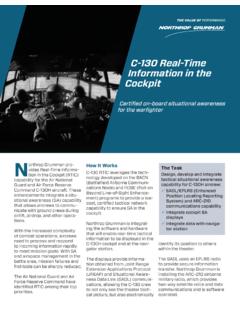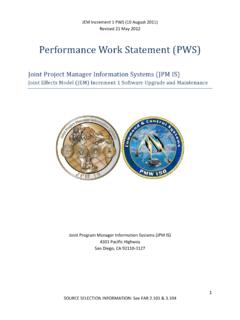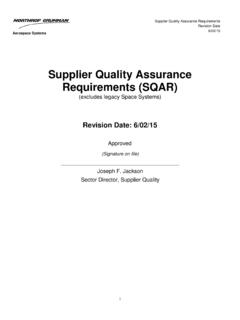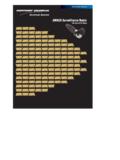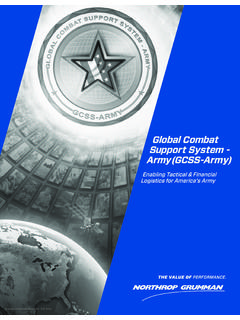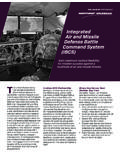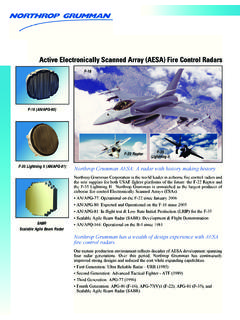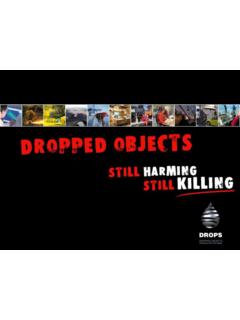Transcription of ANALYSIS CENTER PAPERS Ground Moving Target …
1 ANALYSIS CENTER PAPERSANALYSIS CENTER PAPERSbyRichard J. Dunn, IIIP rice T. BinghamCharles A. Bert FowlerFebruary 2004 Ground Moving TargetIndicator RadarGround Moving Target Indicator RadarAnd the Transformation of WarfightingAnd the Transformation of U S WarfightingEXECUTIVESUMMARY.. : GROUNDMOVINGTARGETINDICATORRADAR ANDTRANSFORMATION.. RADARTECHNOLOGY.. OFGMTI .. 11 COLDWARMILITARYREQUIREMENTS.. 11 GMTI TECHNOLOGYDEVELOPMENT.. 11 POST-COLDWAREMPLOYMENT OFGMTI .. 13 The Gulf War .. 13 Kosovo .. 14 Afghanistan .. 15 Iraq .. FROMRECENTCONFLICTS.. 19 POSITIVETRENDS.. 19 NEGATIVETRENDS.. 20 TRENDIMPLICATIONS.. CAPABILITIES.. OFGMTI SPOTENTIAL.. 23 FASTERMANEUVER.. 23 MOREEFFECTIVEFIRES.
2 24 FASTER ANDBETTERDECISIONMAKING.. 25 FASTER, LOWER-LEVELJOINTINTEGRATION.. 25 RESULT: TRANSFORMED, HIGHTEMPOOPERATIONS.. 26 VII. CONCLUSION: GMTI AND THETRANSFORMATION WARFIGHTING.. 27 VIII. GMTI PERFORMANCEMETRICSAPPENDIX.. 29 GMTI Radar and the Transformation of WarfightingANALYSIS CENTER PAPERSC ontents1 GMTI Radar and the Transformation of WarfightingANALYSIS CENTER PAPERSbyRichard J. Dunn, IIIP rice T. BinghamCharles A. Bert FowlerFebruary 2004 Ground Moving TargetIndicator RadarAnd the Transformation of WarfightingEXECUTIVESUMMARYI ntroduction: Ground Moving Target Indicator Radar andTransformation (p. 5) Among the technological advantages forces haveenjoyed in recent conflicts, information superiority stands out as the capabilitythat truly differentiates forces from all other militaries.
3 The purpose of thispaper is to examine one of the key technologies contributing to informationsuperiority Ground Moving Target Indicator (GMTI) radar and itsimplications for the transformation of the way the United States fights its can help transform Intelligence, Surveillance, and Reconnaissance(ISR), a mission area essential to the battlefield information advantage,because it can depict vehicular movement of enemy forces in near-real timethroughout a large area, regardless of weather. This unprecedented capabil-ity reduces uncertainty, clearing the Clausewitzian fog of war that has hungover land battles for centuries, thereby multiplying the capability of the com-bined force and transforming the execution of air-land operations.
4 GMTI Radar Technology (p. 7)The asymmetrical advantage modern GMTI technology provides forces results from itsunique ability to distinguish targets Moving onland or water from surface clutter over a largearea. This is possible even in bad weather anddarkness by virtue of the Doppler radar return ofthe Moving targets . The GMTI picture showsmoving vehicles as dots overlaid on a digital History of GMTI (p. 11)Cold War Military RequirementsThe propelling force behind development of thecapability to track Moving forces in near-real timewas Cold War military necessity. After the 1973 Arab-Israeli War, senior Army leaders real-ized that to defeat the Soviets under the highlylethal conditions of modern warfare, field com-manders would have to know the enemy s situa-tion beyond the front Technology DevelopmentModern GMTI radar technology evolved fromthe Army s Stand-Off Target AcquisitionSystem (SOTAS) and the Air Force/DefenseAdvanced Research Projects Agency (DARPA)Assault Breaker/Pave Mover programs developedin the 1970s.
5 When it became clear that neitherthe Office of the Secretary of Defense (OSD) norCongress would fund separate GMTI programsfor the two services, Army and Air Force leadersagreed to a single program, Joint STARS(Surveillance and Target Attack Radar System),that would provide battle management of strikeaircraft for the Air Force and wide area surveil-lance for the Army. Post-Cold War Employment of GMTIWhen the end of the Cold War eliminated theSoviet threat, some defense experts suspected thatJoint STARS was no longer needed. However,GMTI platforms have played key roles in almostall subsequent Gulf War Two developmental JointSTARS aircraft supported Coalition forcesengaged in Operation Desert Storm. Early in theWar, during the Battle of Al Khafji, they locatedadvancing Iraqi Ground forces that had attackedat night in an effort to avoid detection.
6 WhenIraqi forces began withdrawing from Kuwait,GMTI was again the source of timely, reliableinformation that enabled air attacks to disruptthe Iraqi retreat. Kosovo Despite the magnitude of its contribu-tion in the Gulf War, GMTI was not fullyexploited in planning for Operation Allied Forcein Kosovo. However, operational experience withGMTI soon led commanders, their staffs, andaircrews to appreciate its capabilities recogniz-ing, for example, that its ability to detect, locate,and track vehicular movement reduces the needfor inefficient visual searches. When the KosovoLiberation Army (KLA) began its offensive, JointSTARS GMTI helped create a dilemma for Serbforces. If the Serbs attempted to maneuver, themovement made their forces visible to GMTIand thus vulnerable to NATO air attack.
7 If theSerbs did not move, they handicapped their abil-ity to achieve the force ratios and position neededto defeat the lighter KLA forces. Afghanistan Joint STARS operations duringOperation Enduring Freedomin Afghanistan hadmany similarities to previous conflicts. As inKuwait and Kosovo, Joint STARS was notdeployed in sufficient numbers for persistent cov-erage. Like Kosovo, the presence of civiliansrequired positive Target identification by anunmanned aerial vehicle (UAV) or manned air-craft. However, Joint STARS enhanced othersurveillance assets by cueing UAVs with high-resolution but restricted field-of-view Alliance units supported by Operations Forces (SOF) threatenedTaliban and al Qaeda forces sufficiently to causethem to move in vehicles, allowing GMTI todetect, locate, and track them.
8 Iraq and British forces in OperationIraqi Freedombenefited from the Joint STARS lessons learned from previous conflicts. For thefirst time, sufficient aircraft were deployed tomeet the GMTI requirement for a major portionof the operational area. Because GMTI wascapable of detecting vehicular movement, Iraqicommanders and their forces faced the same2 GMTI Radar and the Transformation of WarfightingANALYSIS CENTER PAPERS operational and tactical dilemma the Serbs facedin Kosovo. If they moved, they were seen byGMTI and attacked by air or artillery. If theydispersed and remained camouflaged and dug in,they were either bypassed or defeated in detail byground forces. Trends from Recent Conflicts (p.)
9 19)Positive TrendsBy revealing battlefield movement in near-realtime regardless of weather or light conditions,GMTI has begun to transform ISR capabili-ties, contributing to a new American way ofwar in which information and precision reducethe amount of time and mass required, signifi-cantly speeding up military operations. Near-realtime, dynamic GMTI targeting information cou-pled with weather-independent precision guidedmunitions, such as JDAMs, has also redefinedboth close air support and battlefield air interdic-tion by allowing these tasks to be performedeffectively by high-altitude it has continuous wide-area coverage,GMTI provides a battlefield picture that can beused for airborne command and control, to pro-vide near-real time situational awareness to com-manders, and to cue other ISR systems.
10 Byfocusing the efforts of other ISR elements, GMTIhas increased the effectiveness and efficiency ofthe entire ISR it provides an identical Ground truth picture to air and Ground users alike, GMTI helps joint, air, and Ground commanders share acommon understanding of the battlefield, itsdangers, and opportunities for exploitation. Negative TrendsIn the first three conflicts GMTI capability wasinsufficient to provide the desired 24/7 coverageof all major operational areas. Planners havebeen slow to incorporate GMTI or deploy it earlyenough in a conflict to take advantage of its capa-bilities. Terrain, foliage and opportunities forenemy Ground forces to disperse or avoid maneu-ver can hinder detection and tracking by lessons also have had to be relearned fromconflict to conflict, indicating that both doctrinaland organizational development have yet to capi-talize on GMTI s capabilities.
